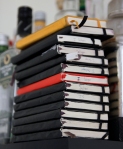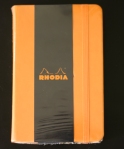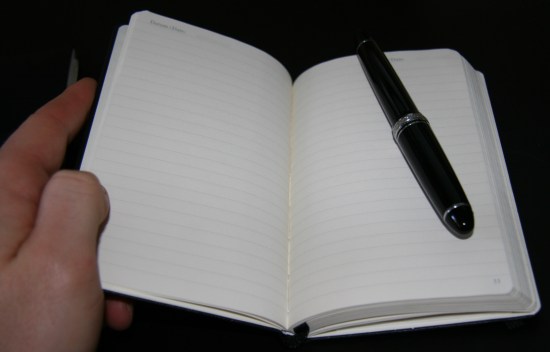“Despite being a denizen of the digital world, or maybe because he knew too well its isolating potential, Jobs was a strong believer in face-to-face meetings.” That’s from Walter Isaacson’s biography of Steve Jobs. It’s a strange way to begin a post about notebooks, but Jobs’ views on the power of a potentially anachronistic practice applies to other seemingly anachronistic practices. I’m a believer in notebooks, though I’m hardly a luddite and use a computer too much.
The notebook has an immediate tactile advantage over phones: they aren’t connected to the Internet. It’s intimate in a way computers aren’t. A notebook has never interrupted me with a screen that says, “Wuz up?” Notebooks are easy to use without thinking. I know where I have everything I’ve written on-the-go over the last eight years: in the same stack. It’s easy to draw on paper. I don’t have to manage files and have yet to delete something important. The only way to “accidentally delete” something is to leave the notebook submerged in water.
A notebook is the written equivalent of a face-to-face meeting. It has no distractions, no pop-up icons, and no software upgrades. For a notebook, fewer features are better and fewer options are more. If you take a notebook out of your pocket to record an idea, you won’t see nude photos of your significant other. You’re going to see the page where you left off. Maybe you’ll see another idea that reminds you of the one you’re working on, and you’ll combine the two in a novel way. If you want to flip back to an earlier page, it’s easy.
The lack of editability is a feature, not a bug, and the notebook is an enigma of stopped time. Similar writing in a computer can function this way but doesn’t for me: the text is too open and too malleable. Which is wonderful in its own way, and that way opens many new possibilities. But those possibilities are different from the notebook’s. It’s become a cliche to argue that the technologies we use affect the thoughts we have and the way we express those thoughts, but despite being cliche the basic power of that observation remains. I have complete confidence that, unless I misplace them, I’ll still be able to read my notebooks in 20 years, regardless of changes in technology.
In Distrust That Particular Flavor, William Gibson says, “Once perfected, communication technologies rarely die out entirely; rather, they shrink to fit particular niches in the global info-structure.” The notebook’s niche is perfect. I don’t think it’s a coincidence that Moleskine racks have proliferated in stores at the same time everyone has acquired cell phones, laptops, and now tablets.
In The Shallows, Nicholas Carr says: “The intellectual ethic is the message that a medium or other tool transmits into the minds and culture of its users.” Cell phones subtly change our relationship with time. Notebooks subtly change our relationship with words and drawings. I’m not entirely sure how, and if I were struggling for tenure in industrial design or psychology I might start examining the relationship. For now, it’s enough to feel the relationship. Farhad Manjoo even cites someone who studies these things:
“The research shows that the type of content you produce is different whether you handwrite or type,” says Ken Hinckley, an interface expert at Microsoft Research who’s long studied pen-based electronic devices. “Typing tends to be for complete sentences and thoughts—you go deeper into each line of thought. Handwriting is for short phrases, for jotting ideas. It’s a different mode of thought for most people.” This makes intuitive sense: It’s why people like to brainstorm using whiteboards rather than Word documents.
 I like to write in notebooks despite carrying around a smartphone. Some of this might be indicative of the technology I grew up with—would someone familiar with smartphone touchscreens from age seven have sufficiently dexterous fingers to be faster than they would be with paper?—but I think the obvious answer to “handwriting or computer?” is “both, depending.” As I write this sentence, I have a printout of a novel called ASKING ANNA in front of me, covered with blue pen, because editing on the printed page feels different to me than editing on the screen. I write long-form on computers, though. The plural of anecdote is not data. Still, I have to notice that using different mediums appears to improve the final work product (insert joke about low quality here).
I like to write in notebooks despite carrying around a smartphone. Some of this might be indicative of the technology I grew up with—would someone familiar with smartphone touchscreens from age seven have sufficiently dexterous fingers to be faster than they would be with paper?—but I think the obvious answer to “handwriting or computer?” is “both, depending.” As I write this sentence, I have a printout of a novel called ASKING ANNA in front of me, covered with blue pen, because editing on the printed page feels different to me than editing on the screen. I write long-form on computers, though. The plural of anecdote is not data. Still, I have to notice that using different mediums appears to improve the final work product (insert joke about low quality here).
There’s also a shallow and yet compelling reason to like notebooks: a disproportionate number of writers, artists, scientists, and thinkers like using them too, and I suspect that even contemporary writers, artists, scientists, and thinkers realize that sometimes silence and not being connected is useful, like quiet and solitude.
In “With the decline of the wristwatch, will time become just another app?”, Matthew Battles says:
Westerners have long been keenly interested in horology, as David Landes, an economic historian, points out in Revolution in Time, his landmark study of the development of timekeeping technology. It wasn’t the advent of clocks that forced us to fret over the hours; our obsession with time was fully in force when monks first began to say their matins, keeping track of the hours out of strict religious obligation. By the 18th century, secular time had acquired the pressure of routine that would rule its modern mode. Tristram Shandy’s father, waiting interminably for the birth of his son, bemoans the “computations of time” that segment life into “minutes, hours, weeks, and months” and despairs “of clocks (I wish there were not a clock in the kingdom).” Shandy’s father fretted that, by their constant tolling of the hours, clocks would overshadow the personal, innate sense of time—ever flexible, ever dependent upon mood and sociability.
The revolution in electronic technology is wonderful in many ways, but its downsides—distraction, most obviously—are present too. The notebook combats them. Notebooks are an organizing or disorganizing principle: organizing because one keeps one’s thoughts, but disorganizing because one cannot rearrange, tag, and structure thoughts in a notebook as one can on a screen (Devonthink Pro is impossible in the real world, and Scrivener can be done but only with a great deal of friction).
Once you try a notebook, you may realize that you’re a notebook person. You might realize it without trying. If you’re obsessed with this sort of thing, see Michael Loper / Rands’ Sweet Decay, which is better on validating why a notebook is important than evaluating the notebooks at hand. It was also written in 2008, before Rhodia updated its Webbie.
Like Rands, I’ve never had a sewn binding catastrophically fail. As a result, notebooks without sewn bindings are invisible to me. I find it telling that so many people are willing to write at length about their notebooks and use a nominally obsolete technology.
Once you decide that you like notebooks, you have to decide which one you want. I used to like Moleskines, until one broke, and I began reading other stories online about the highly variable quality level.
So I’ve begun ranging further afield.
I’ve tested about a dozen notebooks. Most haven’t been worth writing about. But by now I’ve found the best reasonably available notebooks, and I can say this: you probably don’t actually want a Guildhall Pocket Notebook, which is number two. You want a Rhodia Webnotebook.
Like many notebooks, the Guildhall starts off with promise: the pages do lie flat more easily than alternatives. Lines are closely spaced, maximizing writable area, which is important in an expensive notebook that shouldn’t be replaced frequently.
 I like the Guildhall, but it’s too flimsy and has a binding that appears unlikely to withstand daily carry. Mine is already bending, and I haven’t even hauled it around that much. The Rhodia is somewhat stiffer. Its pages don’t lie flat quite as easily. The lines should go to the end of each page. But its great paper quality and durability advantage make it better than the alternatives.
I like the Guildhall, but it’s too flimsy and has a binding that appears unlikely to withstand daily carry. Mine is already bending, and I haven’t even hauled it around that much. The Rhodia is somewhat stiffer. Its pages don’t lie flat quite as easily. The lines should go to the end of each page. But its great paper quality and durability advantage make it better than the alternatives.
The Rhodia is not perfect. The A7 version, which I like better than the 3.5 x 5.5 American version, is only available in Europe and Australia, which entails high shipping costs. The Webbie’s lines should stretch to the bottom of the page and be spaced slightly closer together. The name is stupid; perhaps it sounds better in French. The notebook’s cover extends slightly over its paper instead of aligning perfectly. Steve Jobs would demand perfect alignment. To return to Isaacson’s biography:
The connection between the design of a product, its essence, and its manufacturing was illustrated for Jobs and Ive when they were traveling in France and went into a kitchen supply store. Ive picked up a knife he admired, but then put it down in disappointment. Jobs did the same. ‘We both noticed the tiny bit of glue between the handle and the blade,’ Ive recalled. They talked about how the knife’s good design had been ruined by the way it was being manufactured. ‘We don’t like to think of our knives as being glued together,’ Ive said. ‘Steve and I care about things like that, which ruin the purity and detract from the essence of something like a utensil, and we think alike about how products should be made to look pure and seamless.
I wish the Rhodia were that good. But the Rhodia’s virtues are more important than its flaws: the paper quality is the highest I’ve seen, and none of the Rhodias I’ve bought have broken. If anyone knows of a notebook that combines the Rhodia’s durability with the qualities it lacks, by all means send me an e-mail.
More on the subject: The Pocket Notebooks of 20 Famous Men.
EDIT: See also Kevin Devlin’s The Death of Mathematics, which is about the allure of math by hand, rather than by computer; though I don’t endorse what he says, in part because it reminds me so much of Socrates decrying the advent of written over oral culture, I find it stimulating.
 The Rhodia isn’t perfect. The lines are spaced slightly too wide, at 6.35 mm per line (or .25 inches); they might be great for someone learning how to write, but for someone who already knows, they’re not as useful, and it’s harder to connect ideas on one page to ideas on another. An ideal notebook should be closer to 6 mm per line. Moleskine gets this right. The edge of the cover should be flush with the paper, not a couple millimeters out, forming an unsightly lip. The lines should run to the edge of the page; the current design wastes space, and this is the most important design flaw in the Webnotebook.
The Rhodia isn’t perfect. The lines are spaced slightly too wide, at 6.35 mm per line (or .25 inches); they might be great for someone learning how to write, but for someone who already knows, they’re not as useful, and it’s harder to connect ideas on one page to ideas on another. An ideal notebook should be closer to 6 mm per line. Moleskine gets this right. The edge of the cover should be flush with the paper, not a couple millimeters out, forming an unsightly lip. The lines should run to the edge of the page; the current design wastes space, and this is the most important design flaw in the Webnotebook.






